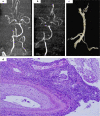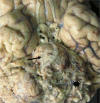Restricted Diffusion of Pus in the Subarachnoid Space: MRSA Meningo-Vasculitis and Progressive Brainstem Ischemic Strokes - A Case Report
- PMID: 21045937
- PMCID: PMC2968771
- DOI: 10.1159/000319691
Restricted Diffusion of Pus in the Subarachnoid Space: MRSA Meningo-Vasculitis and Progressive Brainstem Ischemic Strokes - A Case Report
Abstract
Extra-axial restriction on diffusion weighted imaging (DWI) is an unusual finding on brain magnetic resonance imaging (MRI). Intra-axial restriction on DWI, however, is common, and can represent brain parenchymal infarction, tumor, abscess, or toxic-metabolic process. The infrequency of extra-axial DWI restriction and the paucity of clinico-pathological correlation in the literature limit its differential diagnosis. Scant case reports suggest that extra-axial DWI restriction could be a lymphoma, neurenteric cyst, or, in one patient, subdural empyema [1,2,3]. We postulate that pus formation must be excluded first, because it can provoke an aggressive meningo-vasculitis with rapidly fatal, intra-axial infarctions. Our patient was a 45-year-old man, presenting to our hospital with left facial droop and right (contralateral) arm and leg weakness. Initial MRI revealed DWI restriction in the left lateral pons, consistent with a classic Millard-Gubler stroke. Also noted was a subtle, extra-axial area of curvilinear diffusion restriction in the left cerebellar-pontine angle's subarachnoid space. Days later, the patient had a headache, and repeat MRI revealed extension of the two DWI lesions - both the intra-axial pontine infarction and the extra-axial area of restricted diffusion in the subarachnoid space. The patient became comatose, a third MRI revealed more extensive DWI restrictions, and he expired despite aggressive care. Autopsy revealed massive brainstem infarcts, a thick lymphoplasmacytic infiltrate, copious Gram-Positive cocci (likely MRSA) and arteries partially occluded with fibrointimal proliferation. This emphasizes the concept that extra-axial DWI restriction can represent pus development in the subarachnoid space - a radiographic marker to identify a patient at risk for demise due to septic, meningo-vasculitic infarctions.
Figures






Similar articles
-
Millard-Gubler Syndrome Associated with Cerebellar Ataxia in a Patient with Isolated Paramedian Pontine Infarction - A Rarely Observed Combination with a Benign Prognosis: A Case Report.Case Rep Neurol. 2021 Apr 13;13(1):239-245. doi: 10.1159/000515330. eCollection 2021 Jan-Apr. Case Rep Neurol. 2021. PMID: 33976662 Free PMC article.
-
Smog Sign: Hazy Diffusion-weighted Imaging Restriction in Dense Axonal Tracts in the Pons on Hyperacute MRI with Remarkable Clinical Improvement After Intra-arterial Thrombectomy.Cureus. 2019 Aug 22;11(8):e5461. doi: 10.7759/cureus.5461. Cureus. 2019. PMID: 31641558 Free PMC article.
-
Combination of standard axial and thin-section coronal diffusion-weighted imaging facilitates the diagnosis of brainstem infarction.Brain Behav. 2017 Mar 15;7(4):e00666. doi: 10.1002/brb3.666. eCollection 2017 Apr. Brain Behav. 2017. PMID: 28413710 Free PMC article.
-
Beyond the brain: Extra-axial pathology on diffusion weighted imaging in neuroimaging.J Neurol Sci. 2020 Aug 15;415:116900. doi: 10.1016/j.jns.2020.116900. Epub 2020 May 19. J Neurol Sci. 2020. PMID: 32464349 Review.
-
The Usefulness of Thin-section Iso-Voxel Diffusion Weighted Imaging for Stroke Subtype Classification: Case Series and Review.J Stroke Cerebrovasc Dis. 2020 May;29(5):104755. doi: 10.1016/j.jstrokecerebrovasdis.2020.104755. Epub 2020 Mar 11. J Stroke Cerebrovasc Dis. 2020. PMID: 32171626 Review.
Cited by
-
Crossed brainstem syndrome revealing bleeding brainstem cavernous malformation: an illustrative case.BMC Neurol. 2021 May 20;21(1):204. doi: 10.1186/s12883-021-02223-7. BMC Neurol. 2021. PMID: 34016062 Free PMC article.
-
Diffusion-weighted MRI abnormalities in an outbreak of Streptococcus agalactiae Serotype III, multilocus sequence type 283 meningitis.J Magn Reson Imaging. 2017 Feb;45(2):507-514. doi: 10.1002/jmri.25373. Epub 2016 Jul 29. J Magn Reson Imaging. 2017. PMID: 27469307 Free PMC article.
-
Vertebrobasilar artery dissection manifesting as Millard-Gubler syndrome in a young ischemic stroke patient: A case report.World J Clin Cases. 2019 Jan 6;7(1):73-78. doi: 10.12998/wjcc.v7.i1.73. World J Clin Cases. 2019. PMID: 30637255 Free PMC article.
References
-
- Zacharia TT, Law M, Naidich TP, Leeds NE. Central nervous system lymphoma characterization by diffusion-weighted imaging and MR spectroscopy. J Neuroimaging. 2008;18:411–417. - PubMed
-
- Jan W, Zimmerman RA, Bilaniuk LT, Hunter JV, Simon EM, Haselgrove J. Diffusion-weighted imaging in acute bacterial meningitis in infancy. Neuroradiology. 2003;45:634–639. - PubMed
-
- Lee SB, Jones LK, Gianinni C. Brainstem infarcts as an early manifestation of Streptococcus angisnosus meningitis. Neurocrit Care. 2005;3:157–160. - PubMed
-
- Perry JR, Bilbao JM, Gray T. Fatal basilar vasculopathy complicationg bacterial meningitis. Stroke. 1992;23:1175–1178. - PubMed
Publication types
LinkOut - more resources
Full Text Sources

